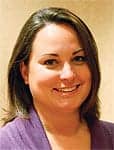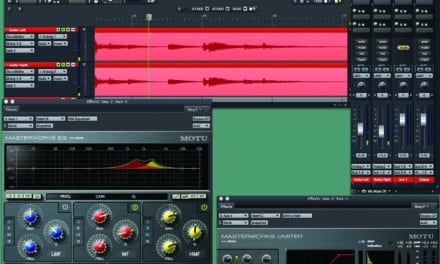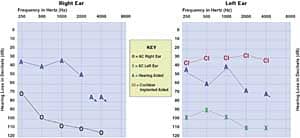The latest generation of PC-based audiometers addresses the need for enhanced test control and scoring features, while offering clinicians options for performing recorded speech at the appropriate pace for each patient.
The dictum seems like a broken record: Recorded speech is a more accurate method for performing speech testing.
While most of us agree we should be using recorded speech, many practices are still resistant to this generally accepted premise. Up to this point, the benefit of greater test control when using live voice has far outweighed the pursuit for accuracy. Looking at a technological landscape that includes smart phones, digital books, Bluetooth connectivity, and tiny netbooks, it seems amazing that audiometers haven’t been able to offer both.
However, the newest generation of PC-based audiometers, like the Madsen Astera, has revolutionized recorded speech testing. These modern audiometers have a whole suite of integrated speech materials and flexible testing options that propel audiometry into the digital age.
Benefits of Standardization
The biggest challenge in using live voice for speech testing is the lack of uniformity in test presentation. In contrast, recorded speech materials reduce variability between presenters and standardize testing with the same patient.
Audiologist Josara Wallber, AuD, of Idaho State University tests patients for whom standardization is not just good practice, it is required. “Especially with cochlear implant patients, using recorded speech is very important,” says Dr Wallber. “It’s a more reliable test than live voice and more valid because the tests are repeatable. Using standardized recorded materials is vital because we need very strong documentation to meet the FDA criteria for surgery. We often see patients who have moved. With recorded speech, we can use the same recorded materials across the nation, and there’s no question whether a patient meets the FDA criteria.”
As a best practice, recorded speech materials also reduce variability between presentation times for a single presenter. A secondary issue with live voice is vocal fatigue, which adds its variation. Not only does fatigue increase the probability of variations in tone, accent, and speaker error, it also increases the potential for artificially inflated results.
The recorded speech materials embedded in a PC-based audiometer can save vocal effort. Perhaps equally as beneficial, they also save time. Embedded recorded speech materials are pre-calibrated to peak the VU meter appropriately each time, no matter how many patients are seen in one day. Since there is no need to calibrate the VU meter with embedded speech materials, testing starts much faster.
Flexible Test Control
The embedded recorded speech materials are controlled through the counting options and the playing options. These two features give audiologists and dispensing professionals the ability to present words as quickly and with as much flexibility as using live voice.

|
| FIGURE 1. WRS testing with embedded speech materials on the Madsen Astera. |

|
| FIGURE 2. Count incorrect words only, correct words only, or both. |
Scoring options. Clinicians can use the counting options for scoring both words and phonemes. They can also choose to set the number of words for playback. However, rather than trying to remember how many words the patient got right, or finger-counting the words they missed, the software scores the test in real-time. Whether setting the count to incorrect words only, correct words only, or both correct and incorrect words, clinicians find that letting the computer track the patient’s progress eliminates the frustration of mentally losing count and saves time from not having to start over (Figures 1 and 2).
Presentation interval options. The playing options also provide flexible test control and speed up testing. In live voice testing, the clinician determines when the next word will be presented. With the embedded recorded speech, they can do the same by choosing “play on count,” which automatically presents the next word when the clinician scores the previous one. This option is especially helpful for Word Recognition Score (WRS) testing, as it allows the clinician to adopt a pace that is most appropriate for an individual patient’s responses.
Alternatively, words can be presented at regular intervals using “continuous play.” This option is commonly used for Speech Recognition Threshold (SRT) testing to familiarize patients with the word list and for the threshold search. The third option, “time out,” also works for both tests because it can present the next word after the previous one has been scored or after a time interval set by the clinician.
Navigation, word selection, and re-scoring via computer mouse. In addition to these playing options, using a mouse to navigate the embedded recorded list increases the speed of presenting the words. Clinicians can double-click on a single word in the list for random word presentation, allowing them to skip from one word to another if desired. This is especially useful in SRT testing for a patient with specific needs or challenges (eg, limited vocabulary).
Double-clicking can also be used to repeat a word in the middle of playing a list, if needed. Many clinicians are relieved to find that it is easy to re-score a word if the score was entered erroneously: simply right-click to see options for changing the score.
Additional corrections can be made by right-clicking in the scoring area and selecting “Enter data by typing.” After using the counting and playing options, monitored live voice testing begins to seem clumsy by comparison.
Going Digital
Downloadable materials. PC-based audiometers are much like smart phones because they can be personalized to the way an individual wants to see information. For example, when a user loads a GPS application into a smart phone, the software saves the user’s preferences so that it can more quickly pull up directions to a destination. The audiometer’s custom user tests are similar: they allow users to save their preferences so that they can more quickly get the test started. “My test time has decreased to about 35 minutes, says Erin Burns, AuD, of Lamar University in Beaumont, Tex. “I set up the pre-sets, and now I just hit a button to go quickly through the user tests.”
Like loading CDs into an MP3 player, recorded materials on CDs can be downloaded onto the PC-based audiometer hard drive. Dr Burns, who routinely performs a battery of auditory processing tests, presents all of her recorded materials from the audiometer: “I’m no longer losing discs or spending time looking for them. Once the CD files were downloaded, I attached the most commonly used files to the user test function. It’s very user-friendly and faster to load than a CD.” Dr Wallber agrees: “With the lists on the hard drive, there’s no reason not to use them. They’re just as fast as live voice now.”
Multilingual and customized scoring capabilities. For Genevieve Bosse, an audiologist at Children’s Hospital of Eastern Ontario, downloading the word lists is essential for a patient population that speaks different languages. “I like the integrated PBK-50 word list because English is my second language,” says Bosse. “As a standardized test, it’s very easy to score. We would like to add more integrated lists in both English and French.” The instrument allows clinicians to create a single database of many recorded speech lists instead of relying on various external media sources.
PC-based audiometers also have the capacity to store several word recognition scores for each ear. Tom Muller, AuD, an audiologist at the University of Arizona-Tucson, describes their clinical procedure for WRS: “We use the BYU recordings and regularly use three or more word lists per ear to establish PBMax.” Dr Muller almost exclusively uses recorded speech materials, because he says they “allow for better standardization; an apples to apples comparison within and across clinics.”
Eliminating Office Clutter

|
| FIGURE 3. Audiometric keyboard fits in a computer keyboard tray. |
Outdated machines, paper copies of word lists, CD players, and tape players can cause clutter in an office or clinic. PC-based audiometers have a much smaller footprint—even the keyboard can be stored in a tray—and don’t require as many peripherals (Figure 3). Not only is there no need for an external media player, but clinicians can move their stacks of CDs into storage.
Since the words are shown on the screen as they are presented, clinicians can clearly see the test progress as each word is presented and scored. This also decreases the potential for lip-reading or the need to hold a piece of paper in front of the presenter’s mouth to prevent patients from lip-reading.
Not only do integrated speech materials decrease clutter and make an office look more professional, they also save time. Think of the time it takes to track down a legible copy of a word list, find the corresponding CD and load it, or do both of those things. Now imagine that all of the recordings are loaded on the audiometer’s hard drive, which can be accessed with a couple of clicks. With a PC-based audiometer, a day of back-to-back hearing evaluations becomes more efficient and less stressful.
Conclusion
Hearing care professionals understand the need for using standardized speech test materials. The concept of recorded speech is not new in this regard; in fact, many audiometers offer the ability to perform accurate recorded speech and incorporate many word lists. The issue is that, until now, recorded speech testing was perceived as slow and inflexible for testing patients with different aptitudes.
The latest generation of PC-based audiometers addresses these needs for enhanced test control and offers clinicians options for performing recorded speech at the appropriate pace for each patient. With the additional ability to store electronic copies of recorded word lists, these new audiometers are on par with the advanced technology of popular electronic devices on the market today. Now that integrated recorded speech materials are just as fast and equally as flexible as live voice, there’s no reason not to give such a PC-based audiometer a try.
Citation for this article:
Mikolai T, Mroz AC. Modern speech audiometry with integrated recorded speech materials. 2010;17(12):30-33.Hearing Review.







